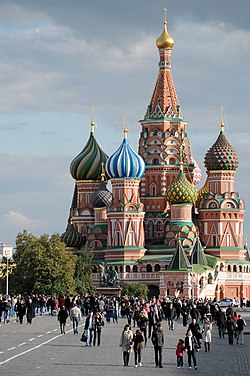
Back الدين في روسيا Arabic Рәсәйҙә дин Bashkir Рэлігія ў Расеі BE-X-OLD Religion in Russland German Θρησκεία στη Ρωσία Greek Religión en Rusia Spanish دین در روسیه Persian Uskonto Venäjällä Finnish Religion en Russie French דת ברוסיה HE

Religion in Russia is diverse, with Orthodox Christianity being the most widely professed faith, but with significant minorities of non-religious people and adherents of other faiths.[1] A 1997 law on religion recognises the right to freedom of conscience and creed to all the citizenry, the spiritual contribution of Orthodox Christianity to the history of Russia, and respect to "Christianity, Islam, Buddhism, Judaism and other religions and creeds which constitute an inseparable part of the historical heritage of Russia's peoples",[3] including ethnic religions or paganism, either preserved, or revived.[4] According to the law, any religious organisation may be recognised as "traditional", if it was already in existence before 1982, and each newly founded religious group has to provide its credentials and re-register yearly for fifteen years, and, in the meantime until eventual recognition, stay without rights.[3]
The Russian Orthodox Church, though its influence is thin in some parts of Siberia and southern Russia, where there has been a perceptible revival of pre-Christian religion,[5] acts as the de facto, if not de jure, privileged religion of the state, claiming the right to decide which other religions or denominations are to be granted the right of registration.[3] Some Protestant churches which were already in existence before the Russian Revolution have been unable to re-register, and the Catholic Church has been forbidden to develop its own territorial jurisdictions.[6] According to some Western observers, respect for freedom of religion by Russian authorities has declined since the late 1990s and early 2000s.[7][8] For example, the activities of the Jehovah's Witnesses are currently banned in Russia. According to International Christian Concern, during 2021 "crackdowns on religious freedom have intensified in Russia."[9]
Since the dissolution of the Soviet Union in 1991 there has been a revival and spread of Siberian shamanism[10] (often mixed with Orthodox elements[11]), and the emergence of Hinduism[12] and new religious movements throughout Russia. There has been an "exponential increase in new religious groups and alternative spiritualities", Eastern religions and Neopaganism, even among self-defined "Christians"—a term which has become a loose descriptor for a variety of eclectic views and practices.[13] Russia has been defined by the scholar Eliot Borenstein as the "Southern California of Europe" because of such a blossoming of new religious movements, and the latter are perceived by the Russian Orthodox Church as competitors in a "war for souls".[13] However, the multiplicity of religions in Russia has been a traditional component of Russian identities for hundreds of years, contributing to a long-established ethno-cultural pluralism.[14]
One of the 2020 amendments to the Constitution of Russia has a Constitutional references to God.[15]
- ^ a b c "Арена: Атлас религий и национальностей" [Arena: Atlas of Religions and Nationalities] (PDF). Среда (Sreda). 2012. See also the results' main interactive mapping and the static mappings: "Religions in Russia by federal subject" (Map). Ogonek. 34 (5243). 27 August 2012. Archived from the original on 21 April 2017. The Sreda Arena Atlas was realised in cooperation with the All-Russia Population Census 2010 (Всероссийской переписи населения 2010), the Russian Ministry of Justice (Минюста РФ), the Public Opinion Foundation (Фонда Общественного Мнения) and presented among others by the Analytical Department of the Synodal Information Department of the Russian Orthodox Church. See: "Проект АРЕНА: Атлас религий и национальностей" [Project ARENA: Atlas of religions and nationalities]. Russian Journal. 10 December 2012.
- ^ Cite error: The named reference
Filinawas invoked but never defined (see the help page). - ^ a b c Bourdeaux 2003, p. 47.
- ^ Fagan 2013, p. 127.
- ^ Bourdeaux 2003, p. 46.
- ^ Bourdeaux 2003, pp. 47–48.
- ^ Uzzell 2000, p. 168: "Religious freedom grew steadily in Russia from about the mid-1980s to approximately 1993. ... The real religious freedom that existed in practice was ... a result of the turmoil and chaos of the early 1990s, which prevented the Russian elite from keeping a steady hand on things. That hand is firmer now, and there has been a steady deterioration of religious freedom over the past five years. In 1994, the first provincial law restricting the rights of religious minorities was passed, in Tula, about two hundred miles south of Moscow. About one-third of Russia's provinces have passed similar laws since then, and in 1997 the national government passed a law explicitly distinguishing between first-class 'religious organizations' and second-class 'religious groups', which have far fewer rights".
- ^ Knox 2008, pp. 282–283.
- ^ "Religious Freedoms Crackdowns Intensify in Russia". 24 May 2021.
- ^ Kharitonova 2015, passim.
- ^ Znamenski 2003, passim.
- ^ Tkatcheva 1994, passim.
- ^ a b Bennett 2011, pp. 27–28; Borenstein 1999, p. 441.
- ^ Ehlers, Kai (17 July 2014). "Russland verstehen" (in German).
- ^ "'God' amendment to Russian constitution wins wider support".
Cite error: There are <ref group=lower-alpha> tags or {{efn}} templates on this page, but the references will not show without a {{reflist|group=lower-alpha}} template or {{notelist}} template (see the help page).